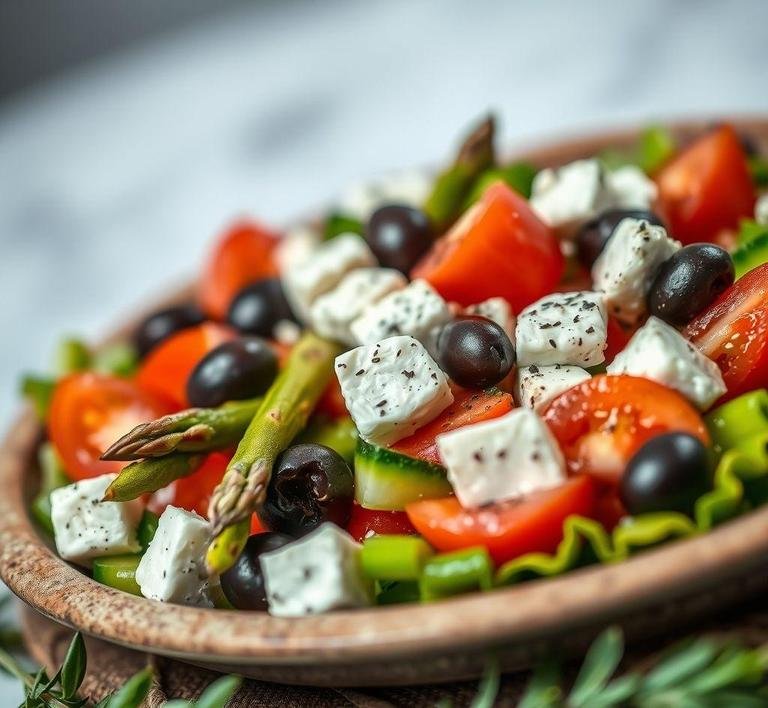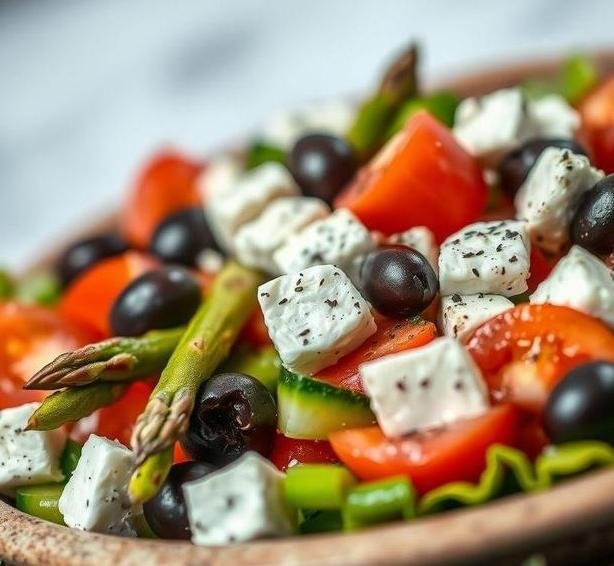Mary Berry’s Greek Salad with Asparagus is a modern twist on the classic Mediterranean dish. Known for her simple, flavorful, and approachable recipes, Mary Berry combines fresh, seasonal ingredients to create a vibrant salad that celebrates the rich, tangy flavors of Greece while incorporating a unique element: tender asparagus. This dish is perfect for spring or summer gatherings, where the natural sweetness of the asparagus pairs harmoniously with the bold, briny notes of feta cheese, olives, and the refreshing crunch of cucumber and tomatoes.
Asparagus is the star of the show in this recipe, bringing an unexpected texture and earthiness to the traditional Greek salad. It’s lightly blanched, just enough to preserve its natural crispness and bright green color, which adds a beautiful contrast to the other colorful ingredients. Paired with a zesty lemon dressing and a medley of Mediterranean vegetables, this Greek salad stands out for its balance of freshness and heartiness, making it a versatile dish that can serve as a light lunch or a side dish for a larger meal.
Mary Berry’s Greek Salad With Asparagus Recipe
Ingredients Needed

To make Mary Berry’s Greek Salad with Asparagus, you’ll need the following ingredients, which combine to form a delicious, refreshing, and nutritious dish:
Fresh Vegetables
- Asparagus (200g): Fresh, tender asparagus spears are the key ingredient, adding both flavor and texture. Opt for thinner spears for a more delicate crunch.
- Cucumber (1 medium): Crisp, hydrating cucumber is essential for that refreshing crunch that balances the richness of the feta and olives.
- Tomatoes (2 large): A couple of ripe, juicy tomatoes cut into wedges contribute a burst of natural sweetness and a touch of acidity that enhances the overall dish.
- Red Onion (1 small): Thinly sliced red onion adds a mild sharpness and a touch of sweetness, bringing depth to the salad.
Cheese And Protein
- Feta Cheese (100g): Crumbled or in large chunks, feta is an iconic part of Greek salads, providing a salty, creamy contrast to the fresh vegetables.
- Black Olives (60g): Kalamata olives are often used, offering a briny, tangy flavor that complements the salad’s other ingredients.
For The Dressing
- Extra Virgin Olive Oil (4 tablespoons): A rich, full-bodied olive oil is essential for making the dressing; it enhances the natural flavors of the ingredients.
- Lemon (1 large): Freshly squeezed lemon juice adds a zesty, citrusy element that brightens the salad and ties all the flavors together.
- Dried Oregano (1 teaspoon): Greek oregano gives the salad an herbaceous aroma and a traditional Mediterranean flavor.
- Salt and Pepper: To taste, balancing the dressing’s acidity and richness.
Equipment Needed
While this Greek Salad with Asparagus is quite simple to prepare, there are a few key pieces of equipment that will make your cooking process smoother:
- Large Mixing Bowl: This will be your go-to container for tossing the salad ingredients and ensuring an even distribution of the dressing.
- Sharp Knife: A sharp chef’s knife is crucial for slicing the vegetables with precision, especially when you’re cutting the cucumber, tomatoes, and asparagus into bite-sized pieces.
- Cutting Board: A large, sturdy cutting board provides a safe surface for chopping and slicing.
- Saucepan or Steamer: For blanching the asparagus, a saucepan with a little boiling water or a steamer basket will be needed to ensure the asparagus stays tender yet crisp.
- Citrus Juicer: If you’re using a lemon, a juicer will help extract the juice more efficiently.
- Serving Dish or Platter: After assembling the salad, you’ll need a large enough serving dish to display the vibrant colors of your Greek salad beautifully.
Instructions To Make Mary Berry’s Greek Salad With Asparagus
Creating this flavorful salad is as easy as it is rewarding. Here are step-by-step instructions to guide you through the process:
-
Prepare The Asparagus
- Begin by washing and trimming the tough ends off the asparagus. Snap the ends off or use a knife to cut the bottom part of each spear.
- Bring a small pot of salted water to a boil. Once boiling, blanch the asparagus by placing the spears into the water for 2-3 minutes, or until they turn bright green and are just tender when pierced with a fork. If you prefer a bit more bite, 2 minutes will suffice.
- Drain and immediately plunge the asparagus into a bowl of ice water to stop the cooking process and preserve the vibrant green color.
-
Prepare The Vegetables
- Slice the cucumber into thin rounds or half-moons, depending on your preference.
- Cut the tomatoes into wedges or bite-sized chunks.
- Thinly slice the red onion into half-moons or rings.
- Cut the asparagus into 2-3 inch pieces after it has cooled.
-
Make The Dressing
- In a small bowl or jar, combine the extra virgin olive oil, freshly squeezed lemon juice, dried oregano, and a pinch of salt and pepper. Whisk together until fully combined. If you prefer a smoother texture, you can shake the mixture in a jar to emulsify it.
-
Assemble The Salad
- In a large mixing bowl, combine the cucumber, tomatoes, onion, asparagus, and black olives. Gently toss to combine.
- Crumble or break the feta into large chunks and add it to the salad.
- Pour the dressing over the salad and toss everything together gently, ensuring that the ingredients are coated evenly with the dressing.
-
Serve And Enjoy
- Once the salad is well-tossed, transfer it to a serving dish or platter.
- You can garnish with additional oregano or a few more crumbles of feta if desired. Serve immediately or refrigerate for a short while to allow the flavors to meld.
Tips And Tricks
- Asparagus Variations: If you’re making this dish during the off-season for asparagus, you can easily substitute it with blanched green beans or even roasted artichokes for a similar texture and flavor.
- Olive Oil Quality: For an elevated flavor, always choose a high-quality, cold-pressed extra virgin olive oil. It adds a silky texture to the dressing and a more intense flavor.
- Feta Choice: While traditional feta cheese is made from sheep’s milk, goat’s milk feta is also delicious. The former tends to have a creamier texture, while goat’s milk feta has a tangier flavor.
- Make Ahead: This salad is ideal for making ahead, as the flavors continue to develop as it sits. Just keep the dressing separate until you’re ready to serve to maintain the freshness of the vegetables.
- Add Protein: If you’d like to make this salad more filling, consider adding grilled chicken, lamb, or even chickpeas for an extra source of protein.
- Chill the Salad: While the vegetables should be fresh and crisp, chilling the salad for a short time before serving can enhance the flavors and give the salad a refreshing, cool feel.
Mary Berry’s Greek Salad with Asparagus is a perfect example of how simplicity and freshness can come together to create something truly delicious. This dish highlights the versatility of the classic Greek salad, infusing it with seasonal asparagus that brings both a unique texture and a mild earthiness to the dish. The combination of fresh vegetables, briny olives, creamy feta, and a zesty lemon dressing makes this salad a refreshing, vibrant choice for any occasion.
Not only is it healthy and full of Mediterranean flavors, but it also takes minimal effort to prepare. Whether you’re looking for a light lunch, a side dish for a barbecue, or a simple dish to serve at a dinner party, this salad is sure to impress. With its vibrant colors and bold flavors, it’s the kind of dish that’s both nourishing and eye-catching-a true celebration of the season’s best ingredients.
Easy Recipe Variations For Mary Berry’s Greek Salad With Asparagus

Mary Berry’s Greek Salad with Asparagus is a wonderfully fresh and light dish, perfect for a spring or summer meal. It combines crisp asparagus, juicy tomatoes, creamy feta, and a zesty dressing that’s simple yet full of flavor. But if you’re looking to switch things up, there are several easy variations to tailor this recipe to your tastes or to add a creative twist.
1. Add Grilled Chicken Or Lamb
For a more substantial dish, consider adding grilled chicken breast or lamb chops to the salad. The rich, smoky flavor of grilled meats pairs beautifully with the crispness of the vegetables and the tang of the feta. Simply season your chicken or lamb with some herbs, olive oil, salt, and pepper before grilling, then slice it thinly and arrange it over the salad. This makes the salad more filling without taking away from its light, fresh qualities.
2. Swap Asparagus For Other Vegetables
While asparagus is the star of the recipe, you can easily swap it out for other in-season vegetables. Try roasted or grilled zucchini, bell peppers, or even artichokes if you’re craving something with a bit more depth. These alternatives offer a similar crunch or soft texture that complements the other ingredients, and they add their own distinct flavors to the salad.
3. Add Olives And Sundried Tomatoes
To enhance the Mediterranean vibe, add Kalamata olives and sundried tomatoes to your Greek salad. The olives will contribute a briny, salty bite, while the sundried tomatoes add a deep umami flavor that complements the freshness of the asparagus and the sharpness of the feta. This simple addition will deepen the flavor profile of your salad and make it even more satisfying.
4. Swap Feta For Goat Cheese Or Halloumi
Feta is a classic choice for Greek salads, but if you’re in the mood for something different, try swapping it out for other cheeses like creamy goat cheese or grilled halloumi. Goat cheese has a tangy, creamy texture that complements the vegetables well, while halloumi, when grilled, takes on a lovely golden crust and a chewy texture. Both are great alternatives to feta and add their own unique qualities to the dish.
5. Make It Vegan
If you’re catering to a vegan diet or simply prefer plant-based meals, you can easily make this salad vegan-friendly. Instead of feta, use a vegan cheese or a handful of crunchy, roasted chickpeas for protein. Nutritional yeast sprinkled on top can mimic the salty, cheesy flavor of feta, while offering a boost of B-vitamins. If you enjoy a more earthy flavor, you could also toss in a few cubes of avocado, which provide richness and a creamy texture.
6. Add A Touch Of Fruit
For a refreshing twist, consider adding fruits such as watermelon, strawberries, or orange slices to the salad. The sweetness of the fruit contrasts beautifully with the salty feta and the tangy dressing, creating a well-rounded flavor experience. Watermelon pairs particularly well with feta, while strawberries offer a vibrant pop of color and a sweet-sour flavor balance.
7. Different Dressings
The dressing for Mary Berry’s Greek Salad is simple-olive oil, lemon juice, and a bit of seasoning-but you can customize it further. Try adding some Dijon mustard or a spoonful of honey for a touch of sweetness and complexity. Alternatively, swap the lemon juice for balsamic vinegar for a more robust, slightly tangy dressing. If you want to give the salad a herby twist, fresh oregano, thyme, or even basil could be added to the dressing to bring in more Mediterranean flavors.
Storing Leftovers
If you’ve made Mary Berry’s Greek Salad with Asparagus and have leftovers, you might wonder how best to store them to keep the ingredients fresh. Although the salad is best enjoyed immediately, with a few tips, you can keep leftovers from losing their flavor and texture.
1. Separate The Components
If you’re anticipating leftovers, it’s a good idea to store the components separately. Asparagus, tomatoes, and any added ingredients like olives or grilled meats can be stored in airtight containers in the fridge. The dressing, however, should be kept separate to avoid wilting the vegetables. If you mix everything together, the salad can become soggy by the next day, and the delicate asparagus could lose its crisp texture.
2. Storing The Salad Base
The asparagus, feta, and any crunchy vegetables should be stored in a container with a tight-fitting lid. Keep the salad base (without dressing) in the fridge for up to two days. To prevent moisture build-up, you can line the container with a paper towel to absorb excess liquid.
3. Refrigerating The Dressing
Store your dressing in a small jar or bottle in the fridge. It can last for up to a week, but always give it a good shake before using, as the olive oil may solidify when chilled. If the dressing becomes too thick, simply add a splash of water or extra lemon juice to loosen it up.
4. Reheating Grilled Meats Or Cheese
If you’ve added grilled chicken, lamb, or halloumi to your salad, store the cooked proteins separately as well. You can reheat grilled meats on a stovetop or in the microwave, but be careful not to overcook them, as they can dry out. If you’ve used halloumi, it’s best to eat it cold as it can lose its texture when reheated.
What To Eat With Mary Berry’s Greek Salad With Asparagus?
While Mary Berry’s Greek Salad with Asparagus is a delicious stand-alone dish, it pairs well with a variety of sides to create a more filling and balanced meal. Here are some suggestions for what to serve alongside it:
1. Warm, Crusty Bread
A loaf of warm, crusty bread is always a welcome addition to any salad, especially when paired with the tangy dressing. You can serve a simple baguette, ciabatta, or focaccia for dipping. If you’re feeling adventurous, try a bread with olive tapenade or sun-dried tomato spread for an extra Mediterranean touch.
2. Grilled Fish Or Seafood
Since the salad has Mediterranean influences, it pairs wonderfully with grilled fish or seafood. Try grilled salmon, seabass, or shrimp for a light and healthy protein to complement the salad. The smoky, savory flavors of the fish or shellfish balance well with the fresh vegetables and creamy feta.
3. Pita Chips Or Crisps
For a bit of crunch and extra texture, serve some pita chips or lightly salted crisps alongside the salad. Pita chips, either homemade or store-bought, will offer a nice contrast to the crisp vegetables and creamy cheese. The salty flavor also enhances the flavors of the salad.
4. Roasted Potatoes
If you’re craving something more substantial, roasted potatoes make an excellent side dish. Opt for crispy, golden baby potatoes, seasoned with garlic, rosemary, and a drizzle of olive oil. Their earthy flavor pairs nicely with the fresh and tangy notes of the salad.
5. Hummus And Baba Ganoush
Add a bit of Middle Eastern flair by serving a few dips like hummus or baba ganoush. The creamy texture of hummus complements the crispness of the salad, while baba ganoush adds a smoky, earthy note. These dips also pair wonderfully with warm pita or vegetables for extra variety.
6. Grilled Vegetables
For a more veggie-centric meal, serve the salad alongside grilled vegetables like eggplant, zucchini, or bell peppers. The smoky flavors of grilled veggies enhance the fresh, zesty qualities of the Greek salad, while also contributing to a well-rounded meal.
Conclusion
Mary Berry’s Greek Salad with Asparagus is a versatile, refreshing dish that brings the best of Mediterranean flavors to your plate. Whether you’re looking for simple recipe variations, tips for storing leftovers, or ideas for what to serve alongside it, this salad offers endless possibilities. From swapping out ingredients to adding grilled meats or extra veggies, you can customize the dish to suit your tastes and dietary needs.
Perfect for any season, this salad is ideal for a light lunch, a side dish, or even as a main course when paired with the right sides. The crisp vegetables, creamy feta, and bright dressing create a balance of flavors that will leave you craving more. So, go ahead-experiment with different ingredients, store your leftovers wisely, and enjoy this delicious dish with whatever sides you fancy.
FAQs
What Ingredients Are Needed For Mary Berry’s Greek Salad With Asparagus?
For Mary Berry’s Greek Salad with Asparagus, you’ll need a selection of fresh vegetables including ripe tomatoes, cucumber, red onion, and green peppers. The key ingredient, of course, is asparagus, which should be blanched briefly to retain its tenderness. You’ll also need Kalamata olives, feta cheese, fresh herbs like parsley, and a dressing made from olive oil, lemon juice, garlic, and a pinch of seasoning. Optional additions can include capers or a sprinkle of oregano for extra flavor.
How Do I Prepare The Asparagus For Mary Berry’s Greek Salad?
To prepare the asparagus, begin by snapping off the tough ends. Blanch the spears by placing them in boiling water for about 2-3 minutes, just enough to soften them without losing their crispness. Immediately transfer the asparagus to a bowl of ice-cold water to halt the cooking process and preserve its vibrant green color. Once chilled, cut the asparagus into 2-inch pieces and add them to the salad along with the other fresh vegetables.
Can I Make Mary Berry’s Greek Salad With Asparagus Ahead Of Time?
Yes, you can prepare most of the components of Mary Berry’s Greek Salad with Asparagus in advance. You can chop the vegetables and prepare the dressing a few hours before serving. However, it’s best to add the asparagus, olives, feta cheese, and dressing just before serving to maintain their freshness and texture. If you do choose to prepare the salad in advance, store the ingredients separately and toss them together just before eating.


